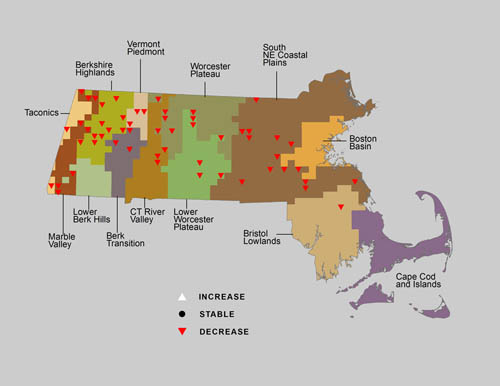Find a Bird
Northern Goshawk
Accipiter gentilis

Local and likely declining
Action/monitoring needed
“Every day that she lived, something else died, and the bird was now approaching the fifth year of her life.” – Pete Dunne, The Wind Masters
The Northern Goshawk is the largest and most seldom-seen breeding accipiter in Massachusetts. These widely distributed predators are handsome as well as being swift, strong, and tenacious. Through the centuries, these traits won them many admirers among falconers and birders alike, but as guns replaced hawks and falcons as the preferred means of bringing down game, they were eventually viewed as competitors rather than allies. Shooting and deforestation thinned goshawk numbers, and before the middle of the twentieth century, breeding Northern Goshawks hardly occurred in Massachusetts at all.
Historic Status
On a summer's day in 1868, an interested gentleman in Weston watched as two Northern Goshawks, or “Partridge Hawks,” soared overhead, never seeming to stray far from a “heavily wooded district.” He searched in vain for a nest, perplexed that this notoriously irruptive winter visitor might be seen in Massachusetts during the warmer months (Howe & Allen 1901). Charles Joseph Maynard, however, in his book on collecting natural trinkets, believed, "Some few undoubtedly breed" in Massachusetts (Maynard 1870). About 50 years later, a nest was found in Townsend, and by the 1920s Northern Goshawks had bred in a handful of towns (Farley 1922). Deforestation most likely affected Massachusetts goshawk populations during the farming era of the early nineteenth century. The species may also have suffered from the extinction of one of its favored prey items – the Passenger Pigeon (Bent 1937).
Atlas 1 Distribution
Northern Goshawks were sparsely distributed in Atlas 1, but these powerful raptors were still present in many areas of the state. The well-forested western ecoregions each had at least a few occupied blocks, save for the Lower Berkshire Hills in the south, but that is not surprising given that the goshawk is close to the southern edge of its Atlantic Coastal breeding range in Massachusetts. Both the Marble Valleys and the Berkshire Highlands reported goshawks in greater than 20% of all blocks. Northern Goshawks were also found breeding in small numbers in the Worcester Plateau and Lower Worcester Plateau regions. Twenty six percent of the species’ Atlas 1 distribution fell in the Coastal Plains, though they occupied comparatively little of that large ecoregion. The bird’s complete absence from the Boston Basin underscores its preference to nest away from human disturbance. Only 2 Possible blocks were reported in the Bristol/Narragansett Lowlands, and no goshawks were found breeding in the pine forests of Cape Cod and the Islands.
Atlas 2 Distribution and Change
The results from Atlas 2 indicate a steady decline in Northern Goshawk breeding activity. While still present in most regions where they were found during the first Atlas, goshawks were gone from the high Taconics and found in only 5% of blocks in the Marble Valleys. A single new block in the Lower Berkshire Hills makes that region the only one in the western half of the state to show increased Northern Goshawk occupancy. Though goshawks were still present in multiple blocks in most regions moving eastward, their occupancy rates at best broke even with Atlas 1 figures and showed large-scale declines at worst. The geographically broad decline of this species is noteworthy.
Atlas Change Map

Ecoregion Data
Atlas 1 | Atlas 2 | Change | ||||||
Ecoregion | # Blocks | % Blocks | % of Range | # Blocks | % Blocks | % of Range | Change in # Blocks | Change in % Blocks |
Taconic Mountains | 2 | 12.5 | 2.7 | 0 | 0.0 | 0.0 | -2 | -13.3 |
Marble Valleys/Housatonic Valley | 9 | 23.1 | 12.3 | 2 | 5.1 | 2.7 | -7 | -17.9 |
Berkshire Highlands | 11 | 20.0 | 15.1 | 11 | 20.0 | 14.9 | -1 | -1.9 |
Lower Berkshire Hills | 0 | 0.0 | 0.0 | 1 | 3.2 | 1.4 | 1 | 3.7 |
Vermont Piedmont | 3 | 17.6 | 4.1 | 1 | 5.9 | 1.4 | -2 | -16.7 |
Berkshire Transition | 5 | 13.2 | 6.8 | 6 | 15.0 | 8.1 | -1 | -3.2 |
Connecticut River Valley | 3 | 5.4 | 4.1 | 5 | 7.7 | 6.8 | 0 | 0.0 |
Worcester Plateau | 11 | 14.1 | 15.1 | 19 | 21.6 | 25.7 | -2 | -4.2 |
Lower Worcester Plateau | 8 | 10.8 | 11.0 | 7 | 8.8 | 9.5 | -3 | -5.6 |
S. New England Coastal Plains and Hills | 19 | 7.0 | 26.0 | 17 | 6.0 | 23.0 | -2 | -0.9 |
Boston Basin | 0 | 0.0 | 0.0 | 1 | 1.8 | 1.4 | 1 | 1.8 |
Bristol and Narragansett Lowlands | 2 | 1.9 | 2.7 | 2 | 1.8 | 2.7 | 0 | 0.0 |
Cape Cod and Islands | 0 | 0.0 | 0.0 | 2 | 1.4 | 2.7 | 2 | 1.7 |
Statewide Total | 73 | 7.5 | 100.0 | 74 | 7.1 | 100.0 | -16 | -1.9 |
Notes
To protect this species we do not disclose the location of occupied blocks, and the map below only registers blocks where the species was present in Atlas 1 but not in Atlas 2. There is a legal, and unfortunately also an illegal, trade in this species. During fieldwork we had one report of a tree climbed, and an entire nest with young removed, and it is likely this illegal practice continues.



